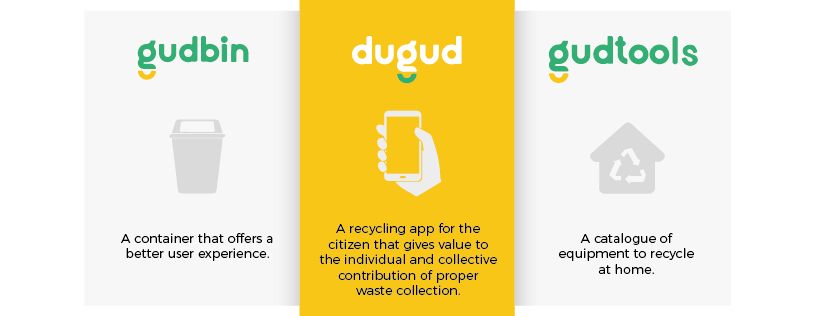Wouldn’t we all like that the environment we live in would magically evolve and change for the better according to our needs? That’s exactly what the concept of responsive cities - the next generation of smart cities - is all about. In this post, we count on the experience of Jorge Tintoré and present a project that has tackled the waste recycling challenges by forming a task force to find out what would enhance the citizen engagement in the endeavor.
Jorge Tintoré, the Project Director at
Ferrovial Servicios, shared this case study from the Spanish municipality of Getxo at the
NextGen Cities event this September. We now outline to our readers the most significant conclusions that they have come to working on the new waste recycling model. Ferrovial is an international service company with yearly sales of nearly 7 billion euros. Almost 40% of these sales are dedicated to urban services. Jorge starts by saying that when speaking about urban innovation, we don’t necessarily speak about totally changing the rules of the game. In fact, it is more about combining different practices, solutions, services that allow us to adapt and anticipate the processes of change in cities. As we’ll see in continuation, it’s possible to have an impact without implementing the latest technologies or investing many resources. The citizens are the driver of change, they are the ones to implement and adapt the new solution. So, once you provide them something that really serves their needs, it is certain to take off.
Concept of Responsive Cities
From the more theoretical side, it’s important to familiarize ourselves with the concept of responsive cities, the definition of next-generation smart cities. In responsive cities, the services are changed taking into account the citizen behavior and the cities are transformed accordingly. Thanks to the technology, the citizen, who wants to be able to know everything, have an active role in the city and be totally interconnected, can now achieve that level of connection. This is a game-changer for how the services are provided.
Roles and Profiles of Citizens
First of all, before entering this subject, we must remember that the concept of citizen is liquid and always changing in this context. The citizen has an ever-changing role in his own life and the circumstances he faces in the morning, afternoon and evening are all different. Therefore, it is very important to understand not only the profile but the changing profile. We have to start thinking about citizen’s motivation, both rational and emotional. Emotions are what move people, so if we want to change cities we have to understand them. It’s common in this context to refer to generations - baby boomers, generation x, millennials, generation z, alpha, etc. These classifications of people according to when they were born surely reflect some common trends. But, at the end of the day, these profiles are also separated by their individual worldview, not only by generations. The generations cannot be the only way to define citizens and their preferences.
Understanding the Citizen, That’s Where the Change Starts
Understanding people is the baseline for providing services. Understanding people and their dreams helps service providers approach the issue of services from a new perspective. We’ve already seen it happening in the private sector. In the end, Netflix or Spotify, among others, have been so successful because they have been able to give the answer to a need that people had, a dream. So why not rethink and redesign other services from the same perspective? Street cleaning, lighting, waste collection or garden and park maintenance are also services aimed at people. The usual client is the administration but we have to evolve to these new models that take into account people and what they really represent. The service provider can propose a bus service with fantastic technological systems but that’s not a guarantee that it’s going to work. To make sure that citizens are going to use it, the analysis of citizen participation and the analysis of behavior change must be carried out.
Case Study: Waste Recycling in Getxo (Spain)
To explain the studies that Ferrovial carries out to understand citizen behavior Jorge Tintoré shared the case of Getxo, a municipality near Bilbao, where they hold a waste collection contract. In this case, the administration was asking us for certain recycling quotas, which Ferrovial was unable to obtain, mainly because the scope of their contract was to collect with a truck. If you recollect from a container, you can add all the sensors and technology you want, collect data and optimize the processes, you still depend on the voluntary contribution of the citizens to take their waste there and recycle accordingly. So, the challenge was to increase recycling by 50%. And the only way to get there was to change the model. Ferrovial agreed with the city council to put together a task force and start studying people. So, Ferrovial assembled a workgroup in which they activated several study levers and carried out the diagnosis of the citizen based on the following:
- Insights
- Collaborative Innovation Sessions
- Semiotics
What Was Studied?
Insights Insights refer to the study of identifying the hidden needs of the citizens, the things they are thinking but don’t always communicate. Ferrovial’s study process is to carry out interviews in which with a very specific methodology they leave space for the citizen to participate, talk, express themselves and say their wishes, concerns, dreams, etc. In general, whether it’s the subject of waste or any other, most people don’t come forward with their opinions or comments. Since they do not have a space to express themselves, they do not spend much time thinking about the issue either. “But if we give them this space, and in this space, we carry on conversations with very specific guidelines, more or less after about 20 minutes of preparation, the citizen begins to think about those issues and uses the opportunity to comment or share the barriers he or she is facing that are less obvious from the outside, “ Jorgé Tintoré commented on their interview process.  For the insights study, Ferrovial interviews about 30-40 people for about 50 minutes. After those conversations, they extract the messages and, at the end the interpreters synthesize them in up to eight insights on the subject. “Then we have the essence to start solving the problem - our first lever,“ Jorge concludes. Collaborative Innovation Sessions The second lever would be the sessions for discovery and collaborative work between people of different profiles: administration, refuse collection truck operators, citizens, merchants. They work together to put forward solutions that cover the needs of different interest groups. Semiotics After all that comes the study of semiotics. Ferrovial applies semiotics as a science that identifies the meaning of things. Above all, to see what are the emotional levers that really lead a person to make a change in his or her attitude.
For the insights study, Ferrovial interviews about 30-40 people for about 50 minutes. After those conversations, they extract the messages and, at the end the interpreters synthesize them in up to eight insights on the subject. “Then we have the essence to start solving the problem - our first lever,“ Jorge concludes. Collaborative Innovation Sessions The second lever would be the sessions for discovery and collaborative work between people of different profiles: administration, refuse collection truck operators, citizens, merchants. They work together to put forward solutions that cover the needs of different interest groups. Semiotics After all that comes the study of semiotics. Ferrovial applies semiotics as a science that identifies the meaning of things. Above all, to see what are the emotional levers that really lead a person to make a change in his or her attitude.
What Did the Study Reveal?
For the citizens, the main motivation was their neighborhood. For "my neighborhood" people would do a lot more than for some wide and elusive greater good. In the context of waste management, when the container changes from "the container" to "my container" and the person identifies with what it represents, we have brought along an important change. Both, the lever of insights and semiotics coincide that identifying with the neighborhood and improving the life of my neighborhood make the citizens engage more. Or in other words, people do much more for their immediate environment if they see the improvements. In the collaborative discovery part, Ferrovial observed that the citizens were looking for ways to communicate with the containers and have technologies for individual or collective identification with the recycling cause.
From Hidden Needs to a New Model
After identifying the previous markers, Ferrovial was ready to define a new model of service delivery. The change, as they say, starts at home. Kitchen to be precise. That is, the living environment and the space where the citizen has the waste bin. The better equipped the home is for holding various bins, the more motivated is the user. The factor to have in mind is when the citizen arrives with the waste to the containers. If there’s a possibility of identification for the citizen, he or she is more likely to feel important and involved in the process. In conclusion, the new model must offer some form of recognition. It must propose something tangible that allows the citizen to feel that he/she is contributing and collaborating and that there are things that change thanks to this contribution. This factor could generate a certain sense of competition among the users.
https://www.youtube.com/watch?v=HfXx88tX33Y
The New Model in Action
The main axes of the new proposal of Ferrovial were:
- Gudbin - A container that offers a better user experience. This is a project that Ferrovial has been working on for two years. It aims to cover most of the requirements of the public and the main focus is to offer the interaction that citizens expect.
- Dugud - A recycling app for the citizen that gives value to the individual and collective contribution of proper waste collection. In this application, citizens can earn points, challenge themselves and feel the value of their effort. It can be used both to connect the citizens with their neighborhood and to promote a circular economy.
- Gudtools - A catalog of home recycling equipment. As we have said, recycling starts at home and if people have a comfortable, beautiful and rewarding solution at home, they are more willing to commit to the cause.

Take-Home Message
If we put the citizens at the center of the services provided in a city, we have a solid base to transform the whole service paradigm. It is in this context that the concept of responsive cities takes on a life and meaning of its own. As we’ve seen in this example of waste recycling from Getxo, technology does play an important part in the solution, but it is nothing from another world. On the contrary, it is the simplest solution that has been found to overcome the challenge that Ferrovial was presented with. The real key to success was understanding the citizenry. To sum up the presentation, Jorge Tintoré recognizes that it is not an easy task to lead the transformation. It requires leaving the comfort zone both in companies and in the administration, but once you do, you might realize that the solution was right in front of you.


 For the insights study, Ferrovial interviews about 30-40 people for about 50 minutes. After those conversations, they extract the messages and, at the end the interpreters synthesize them in up to eight insights on the subject. “Then we have the essence to start solving the problem - our first lever,“ Jorge concludes. Collaborative Innovation Sessions The second lever would be the sessions for discovery and collaborative work between people of different profiles: administration, refuse collection truck operators, citizens, merchants. They work together to put forward solutions that cover the needs of different interest groups. Semiotics After all that comes the study of semiotics. Ferrovial applies semiotics as a science that identifies the meaning of things. Above all, to see what are the emotional levers that really lead a person to make a change in his or her attitude.
For the insights study, Ferrovial interviews about 30-40 people for about 50 minutes. After those conversations, they extract the messages and, at the end the interpreters synthesize them in up to eight insights on the subject. “Then we have the essence to start solving the problem - our first lever,“ Jorge concludes. Collaborative Innovation Sessions The second lever would be the sessions for discovery and collaborative work between people of different profiles: administration, refuse collection truck operators, citizens, merchants. They work together to put forward solutions that cover the needs of different interest groups. Semiotics After all that comes the study of semiotics. Ferrovial applies semiotics as a science that identifies the meaning of things. Above all, to see what are the emotional levers that really lead a person to make a change in his or her attitude.

